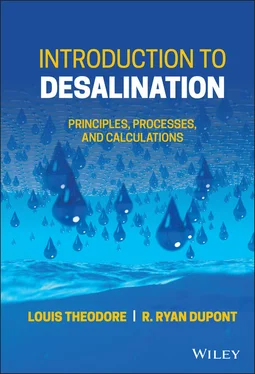Parts per million (ppm) –The fraction (ppmm for mass fraction and ppmv for volume fraction) multiplied by 106; it is a unit used to measure small concentrations of a substance; equivalent to units of mg/L in water.
Pathogenic waste – A discarded waste that contains organisms capable of causing disease.
Percolation – The flow of a liquid downward through a filtering medium or soil layer.
Permafrost – The portion of the Earth which is permanently frozen, such as the Artic regions and portions of Alaska.
Permeability – The degree to which a liquid can move freely through soils.
Physical quality – The physical characteristics possessed by a material; it includes temperature, color, odor, and turbidity.
Physical treatment – A water or wastewater treatment process that utilizes physical means for pollutant removal; processes include screening, grinding, settling, filtration, and centrifugation.
Physicochemical – A term used to describe processes that involve both physical and chemical characteristics; adsorption is one such process that involves both physical and chemical attraction of an adsorbate to an adsorption site.
Point source of pollution – Pollution originating from a discrete source, such as the outflow from a pipe, ditch, tunnel, concentrated animal-feeding operation, or floating craft.
Pollutant – Any harmful substance present in air, water, or soil.
Pollution – The direct or indirect alteration of the physical, thermal, biological, or radioactive properties of any part of the environment in such a way as to create a hazard or potential hazard to the health, safety, or welfare of any living species.
Potable water – Water that is safe for human consumption.
POTW – Publicly owned treatment works, or municipal wastewater treatment plants.
Pre-aeration – A water treatment process in which the removal of dissolved gases, and the addition of oxygen are performed; typically, in aeration towers or aeration tanks.
Precipitate – A solid that separates out from a liquid due to some physical or chemical change in the liquid.
Pretreatment – Any process employed to partially remove pollutants from water prior to any subsequent treatment process.
Psychrometric chart – A chart employed to determine the properties of moist air as a function of temperature.
Public water system (PWS) – Any system that provides piped water for human consumption to at least 15 service connections or regularly serves 25 individuals.
Purging – A cleansing or removal of impurities, foreign matter, or undesirable contaminants from a process through periodic withdrawals of liquids or solids.
Purification – The removal of undesirable constituents from a substance by one or more separation techniques.
Rank – The stage reached by coal in the course of its carbonation; the chief ranks, in order of increasing carbon content, are lignite, subbituminous coal, bituminous coal, and anthracite.
Raw water – The untreated water that enters the first treatment unit of a water treatment plant.
Receiving water – Any body of water (e.g. river, lake, ocean, stream, etc.) into which treated wastewater is discharged to.
Recirculating cooling water – The recycling of cooling water to greatly reduce water use by reusing the water to perform several cooling operations.
Reclaimed water – Treated wastewater that is reused for generally non-potable uses to supplement or replace other raw water supplies.
Recycled water – Wastewater that has been treated for reuse and is recycled, generally for non-potable uses within a home or industrial facility.
Red tide – A proliferation and accumulation of certain microscopic algae, predominantly dinoflagellates, in coastal waters; some species produce toxins that are labeled harmful algae blooms, or Harmful Algal Blooms (HABs), that pose a serious and recurring threat to human health, wildlife, marine ecosystems, fisheries, and coastal aesthetics.
Red water – A rust-colored water, usually resulting from the presence of precipitated ferric iron salts.
Release – Any spilling, leaking, pumping, pouring, emitting, emptying, discharging, injecting, escaping, leaching, dumping, or disposing into the environment.
Renewable water supply – The rate of supply of water (volume per unit time) potentially or theoretically available for use in a region on an essentially permanent basis.
Reproducibility – The ability to repeat an experiment, reaction, measurement, or process and produce the same results.
Reservoir – Any body of water employed for the storage, control, or regulation of water.
Reverse osmosis – A water treatment process employed to separate water from pollutants by the application of pressure to force the water through a semipermeable membrane.
Rinse – The removal of foreign materials from a surface by using a flow of liquid.
Rinse water – Water used to remove debris and contaminants from products and equipment.
Riptide – A strong surface current of short duration flowing outward from the shore.
River basin – The land area drained by a river and its tributaries.
River bed – The bottom of a river.
Runoff – The water from precipitation that exceeds an areas infiltration and storage that flows over the ground into a surface water body.
Rural area – The area outside the limits of any city, town, village, or other designated residential or commercial area.
Saline water – Water that generally is considered unsuitable for human consumption or for irrigation because of its high content of dissolved solids, generally greater than 10,000 mg/L of dissolved solids; 35,000 mg/L dissolved solids is normally assigned to seawater.
Salinity – The amount of salts or minerals dissolved in water.
Salinization – A process in which a soluble salt accumulates in soils.
Salt – A chemical compound formed when the hydrogen ion of an acid is replaced by a metal, or when an acid reacts with a base in an aqueous solution.
Salting out – A reduction in the water solubility of certain molecules in a solution of very high ionic strength.
Saltwater intrusion – The displacement of fresh groundwater by higher density salt water near coastal regions.
Sample – A representative specimen of a liquid, solid, or gas collected for the purpose of determining its composition.
Sampling – A method employed to obtain representative test samples; it consists of the collection, isolation, and the possible concentration of a small fractional part of a larger volume of a media.
Sand bar – A ridge of sand built up by deposition to the surface or near the surface of a river or along a beach.
Sand dune – A mound or ridge of loose sand blown by prevailing winds.
Sanitary survey – An on-site review of water sources, facilities, equipment, operation, and maintenance of a public drinking water system to evaluate the adequacy of those components for producing and distributing safe drinking water.
Saturated rock – A rock that has all of its void spaces filled with fluid.
Saturated soil – A soil that has all of its void spaces filled with fluid.
Saturated zone – A subsurface soil or rock zone in which all the interstices or voids are filled with water.
Saturation temperature – The minimum temperature at which air is saturated with water vapor; the boiling point of water.
Scour – The action of a flowing liquid as it erodes and carries away material on the sides or bottom of a channel.
Screening – The use of screens to separate and remove coarse floating and suspended solids from water.
Sea – A large body of saltwater, second in rank to an ocean, that is generally part of, or connected to an ocean at some point.
Читать дальше












